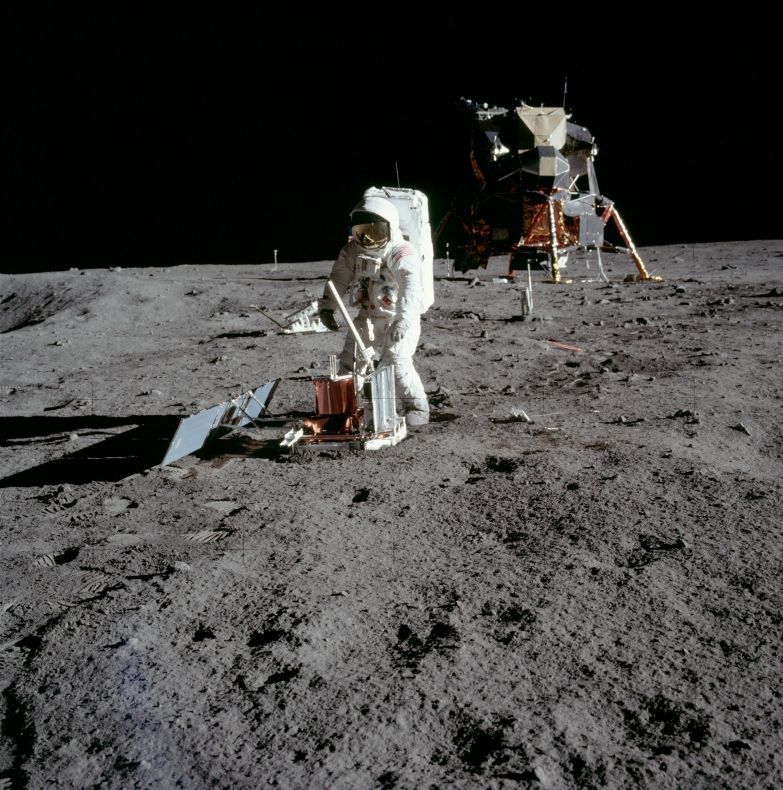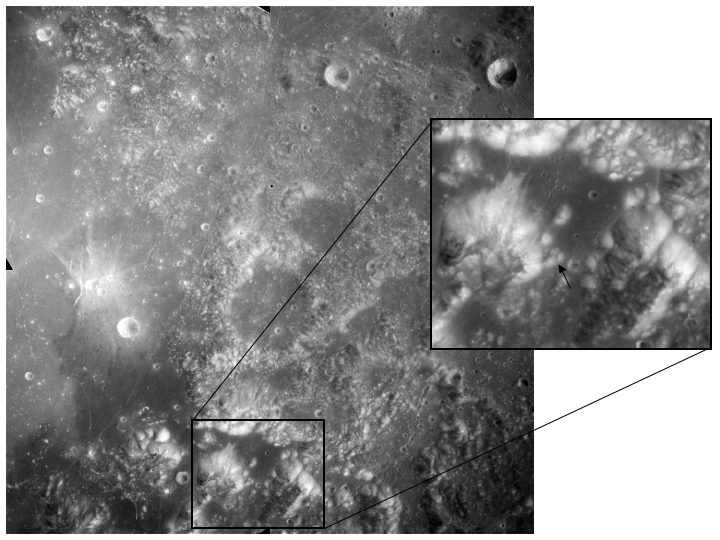
| Project Home | About the Scans | Browse Gallery | Image Map | Support Data | Resources | Ephemeris |
Featured Image - 12/16/2008
IMPACT! Moonquakes and Tremors
The Apollo expeditions to the lunar surface answered some of the most fundamental questions about the Earth's nearest neighbor, but the study of the Apollo dataset and the samples returned by the astronauts has raised a huge number of scientific questions. In the four decades since the premature end of the Apollo project, one of the most prominent questions in lunar science has been the structure and nature of the Moon's interior.
In order to understand the interior structure of the planet, you have to use devices called seismometers. Seismometers are used all over the surface of the Earth and are not only used for scientific research, but also for activities like petroleum exploration and treaty verification.
Seismometers were installed on the surface of the Moon by Apollo astronauts as part of Apollo missions 12, 14, 15, and 16 and transmitted seismic data from the Moon to Earth between 1962 and 1977. Unfortunately, the Apollo seismic network did not include any stations on the far side of the Moon, so the data is difficult to interpret. Whether or not the Moon has a solid core remains a topic of scientific debate, which is why the emplacement of a truly global seismic network will be one of the primary goals of the Return to the Moon effort.
However, the Apollo seismic network revealed that there are several types of moonquakes. Tidal effects between the Earth and Moon produce deep moonquakes that are fairly mild. Some seismic rumblings results from the temperature change between lunar day and night, each of which lasts approximately two weeks. Moonquakes that are focused at very shallow depths beneath the surface can be as strong as an earthquake that registers a 5.5 on the Richter scale. On Earth, that's strong enough to move furniture. On the Moon, these shallow quakes last for many minutes and force the Moon to vibrate or ring like a bell.
Figure 1. Buzz Aldrin deploying a seismometer in Mare Tranquilitatis during Apollo 11. [NASA]
In addition to naturally occuring movement within the Moon, the seismometers also detected the tremors that result from meteorites hitting the Moon. Several spent lunar module ascent stages and Saturn V S-IVB stages used in the Apollo missions were deliberately sent to impact the surface in order to test the effects of these artificial "meteorite" impacts on the seismometers. In all, four lunar modules and five Saturn upper stages were directed to the surface. Scientists were able to observe the impact energy, impact velocity, and angle of impact for all but one of the impacts. On December 15, 1972, the Apollo 17 Lunar Module "Challenger" impacted the Moon in the Taurus-Littrow region. This image, taken with the Apollo 15 Metric camera, shows the region where the impact would eventually occur more than a year later. The 50cm/pixel imagery that will be returned by the Lunar Reconnaissance Orbiter Camera in 2009 will allow lunar scientists to pinpoint the exact positions of some of these artificially-produced impact craters.
Figure 2. Apollo Image AS15-M-0564: Impact site of the Apollo 17 Lunar Module in the Taurus-Littrow region. This image was taken nearly a year and a half prior to the impact. The Apollo 17 Lunar Module "Challenger" impacted the Moon on December 15, 1972 after separation from the Command Module "America". The zoomed portion of the image shows the predicted impact site of the Lunar Module. The most likely landing spot is indicated by the arrow. [NASA/JSC/Arizona State University]
When astronauts return to the Moon, they will do so for many months at a time, far longer than the stay times of Apollo (the longest stay time to date on the lunar surface is only three days). Although the chances of a moonquake causing a significant safety issue for lunar explorers is relatively minor, habitats and structures intended for long-term occupation will be built to withstand any vibrations caused by moonquakes without sustaining damage.
Reference: Science@NASA Moonquakes
Tweet
|
|
Space Exploration Resources |
|
 LPI LPI
|

